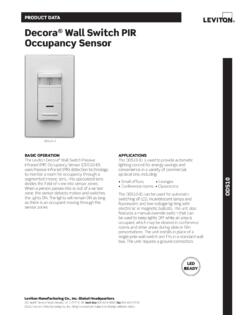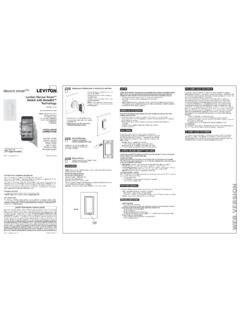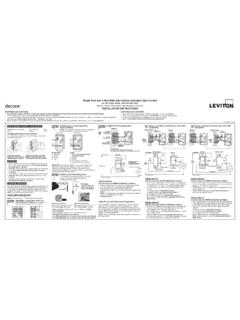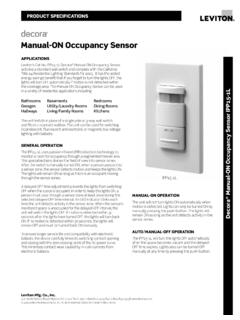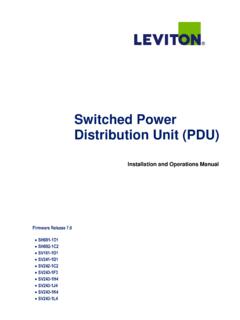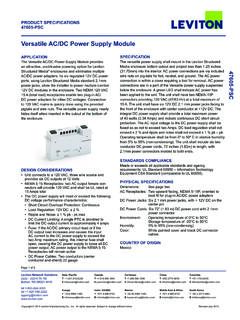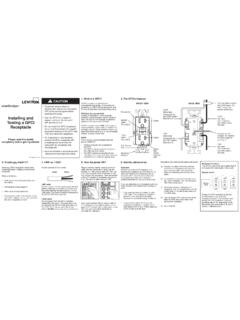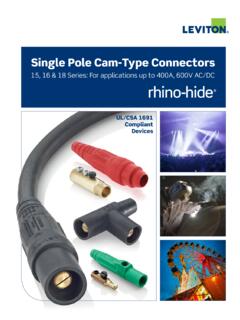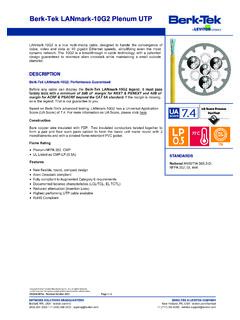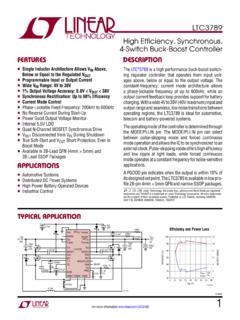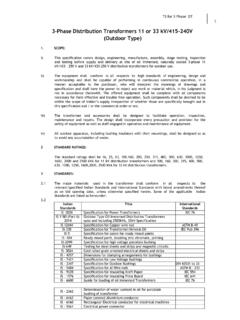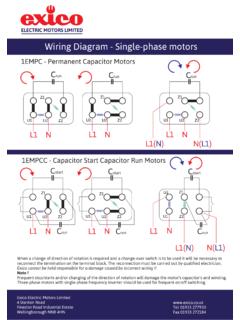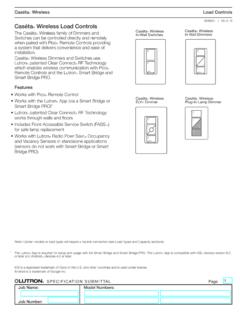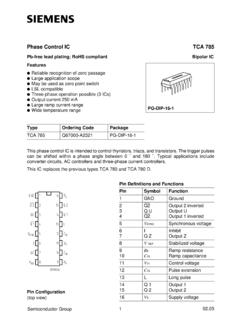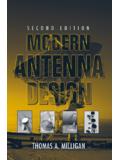Transcription of Forward and Reverse Phase Dimming
1 TECHNICAL APPLICATION NOTEFORWARD AND Reverse Phase DIMMINGF orward and Reverse Phase DimmingForward Phase (Leading Edge) ControlsForward Phase controls modulate the input power by turning ON in the middle of the cycle and turning OFF at the end of the cycle. In order to increase the light output, the power would be turned on earlier; to decrease the light output, the power would be turned on later. This method is also referred to as Leading Edge Dimming because the turn ON edge leads the voltage being applied to the load. The most common technology used to produce Forward Phase controls is Triac based Dimming . In this type of Dimming , a semiconductor acts as a switch, controlling both positive and negative half cycles. Due to the nature of how the triac works in Forward Phase , it is not interrupting current at the end of the cycle, but rather letting the signal go to zero.
2 Triac based Forward Phase controls are commonly used to control Incandescent, LED, CFL, Magnetic Low Voltage (MLV) or Fluorescent controls. MLV and some Fluorescent controls explicitly require Forward Phase controls due to their architecture. MLV loads convert the output from the dimmer to a low voltage output, so that smaller 12V or 24V lamps can be used. These inductive type loads require a Forward Phase control due to potential voltage spikes when current is interrupted in Reverse Phase . Electronic Low Voltage (ELV) loads generally require Reverse Phase controls and are not suitable for Forward Phase Controlled by Forward Phase Controls Note: Each dimmer has individual ratings. Not all Forward Phase dimmers are rated for all these loadsReverse Phase (Electronic Low Voltage) ControlsReverse Phase controls modulate the input power by turning ON in the beginning of the cycle and turning OFF in the middle of the cycle.
3 In order to increase the light output, the power would be turned OFF later; and to decrease the light output, the power would be turned OFF most common technology used to produce Reverse Phase controls are MOSFETS. In this type of Dimming , two MOSFETS act as switches, one on each of the positive and negative half cycles. Due to the use of MOSFETS in the design, Reverse Phase dimmers generally require a neutral wire for Mfg. Co., Inc. 201 North Service Road, Melville, NY 11747 Tech Line: 1-800-824-3005 Fax: 1-800-832-9538 2020 Leviton Manufacturing Co., Inc. All rights reserved. Subject to change without LVFluorescentForward Phase ControlReverse Phase ControlForward Phase ControlReverse Phase ControlPhase-Cut Dimming Phase -cut dimmers work by taking the line input power (120V house power ) and modulating the signal to reduce the power to the load.
4 By chopping the signal, the load experiences a lower voltage, resulting in a lower light output. The two most common Phase -cut controls are Forward Phase controls and Reverse Phase controls, each with their own benefits and limitations. Leviton residential Phase -cut dimmers offer the ideal solution for controlling the light level for any activity within the compatibility can present more challenges when using Forward Phase dimmers as opposed to Reverse Phase dimmers. Selecting the best LED/dimmer pairing is paramount to help ensure the best Dimming experience. To help, Leviton works closely with LED lamp manufacturers and has created a web-based LED Compatibility Selector Tool. Our dedicated team in our in-house lab conducts ongoing testing of the latest LED lamps/fixtures with our LED dimmers to determine the best combinations.
5 This test program measures a number of factors including Dimming range and irregular functionality such as flickering, slow start up, noise (humming/buzzing) levels and inconsistent illumination. The tool is updated regularly with the latest results. Only pairings that meet our rigorous test criteria are published in our user-friendly online LED Compatibility Selector Tool. Try the online tool today at CompatibilityReverse Phase controls are commonly used to control LED, CFL, ELV and some other types of LED Drivers or Incandescent loads. Due to the architecture of ELV loads, Reverse Phase Dimming is generally required and will result in proper performance. While Reverse Phase controls are valuable for certain applications, they cannot be used with MLV loads. Due to the inductive qualities of MLV loads, the interruption of current on the trailing edge of the line signal can result in large kickback voltages.
6 This kickback voltage can cause damage to the dimmer or to the MLV load. Reverse Phase controls can potentially improve LED performance due to the MOSFET control and inclusion of the neutral wire. Some potential performance improvements include: Reduced LED flicker, improved Dimming range and reduced audible our Website at: 2020 Leviton Manufacturing Co., Inc. All rights reserved. Subject to change without LVLoads Controlled by Reverse Phase ControlsLeviton Forward and Reverse Phase ControlsProduct Family Forward Phase SKUsReverse Phase SKUsRotaryRNL06, RDL06n/aToggle SlideTSL06n/aSureSlide 6672,667466 EVIllumaTech IPL06, IPM06, IPM10 IPE04 Decora SlideDSL06, DSM10 DSE06 Decora DigitalTMDDL06, DDMX1 DDE06 Note: Some Leviton ELV dimmers are not rated for LED/CFLLoad Control RequirementsIncandescentCan be controlled by either Forward or Reverse Phase dimmersLEDCan be controlled by either Forward or Reverse Phase dimmers.
7 Generally, will perform better in Reverse Phase because of the characteristics of LED driversM LVCan only be controlled by Forward Phase dimmers due to potential component damage from kickback voltage when current is interrupted in Reverse phaseE LVCan only be controlled by Reverse Phase dimmers due to the characteristics of electronic transformers, where Forward Phase could result in poor performanceWhy certain loads require certain dimmers
